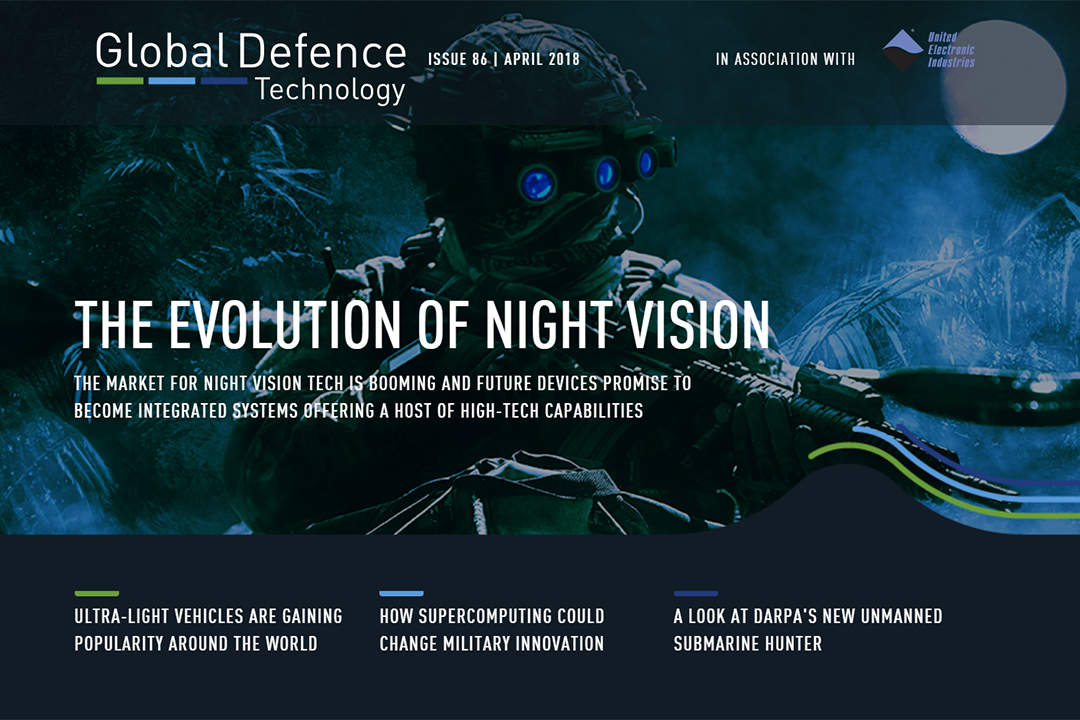
Global Defence Technology is now available to read on all devices.
DARPA has developed a prototype unmanned submarine hunter which it claims could lead to an entirely new class of military vessels, autonomously patrolling the seas for months on end at a fraction of current costs. We find out what that means for submarine warfare as we know it.
We also take a look inside the Northrop Grumman / Orbital ATK deal and ask what it will mean for the defence industry, speak to Hewlett Packard about the capabilities of its new supercomputers for the US Air Force Research Laboratory at Wright-Patterson Air Force Base, and look at the latest innovations in military aircraft.
Plus, we ask whether Canada’s choice of ultra-light combat vehicles from Polaris Industries could set a trend in light options that other countries may follow, and check in on the latest developments in night vision technology.
In this issue
Scanning the M&A landscape: Inside Northrop’s Orbital Acquisition
The pace of mergers and acquisitions in the US defence sector has been accelerating and despite tremors of concern around further consolidation and monopoly, the expected acquisition of Orbital by Northrop Grumman could be a sign of significant reshaping to come. Dr Gareth Evans investigates.
How supercomputing could change warfare forever with HPE
HPE has been selected by the U.S. Department of Defense to provide seven new supercomputers to the Air Force Research Laboratory at Wright-Patterson Air Force Base, to support research into hypersonics and computational modelling of current and advanced air, naval, and ground weapon systems. Claire Apthorp spoke to HPE to find out how supercomputers like these can revolutionise military innovation.
Rise of the ultra-light military vehicle
The Canadian Special Operations Forces Command has taken the delivery of its first ultra-light combat vehicles from US-based Polaris Industries. And they’re not the only ones interested with multiple countries on the lookout for fast and mobile transportation options. Claire Apthorp takes a look at the ultra-light options out there.
Night vision: a light in the dark?
Being able to see in the dark can prove decisive on the battlefield. As General Barry McCaffrey, commander of the US Army’s 24th Infantry Division during Desert Storm, put it, “night vision capability provided the single greatest mismatch of the war.” Dr Gareth Evans reports on the technology’s evolution.
Innovation at the edge: the top air defence trends by domain
Air combat is no longer dominated by dogfights between fighter aircraft. Air superiority now hinges on electronic warfare, networked capabilities and control of the electromagnetic spectrum. Julian Turner looks at the latest innovations informing attack, surveillance, refuelling and logistics aircraft.
Sea Hunter: inside the US Navy’s autonomous submarine tracking vessel
US defence research agency DARPA has developed Sea Hunter, a prototype unmanned submarine tracking vessel with the ability to autonomously patrol the seas for months on end at a fraction of current costs. Julian Turner investigates what this could mean for conventional submarine warfare.
Next issue
Sweden is creating a digital defence system to protect against cyberattacks – specifically from Russia – and working on plans to mobilise troops more quickly. At the same time Norway has unveiled its defence procurement plans to 2025, which will focus on building a highly skilled defence industry. We map defence spending and priorities in the two countries against a backdrop of geopolitical developments.
Sweden is creating a digital defence system to protect against cyberattacks – specifically from Russia – and working on plans to mobilise troops more quickly. Meanwhile, Norway’s procurement plans to 2025 focus on building a highly skilled defence industry. We explore the two countries’ defence spending and priorities against a backdrop of geopolitical developments.
Also in the next issue, we look into France’s €100m spending drive on artificial intelligence-powered future weapons systems, review recent developments in light attack aircraft, and find out why Dstl is going back to basics in its approach to computer hardware for harsh operational environments.



